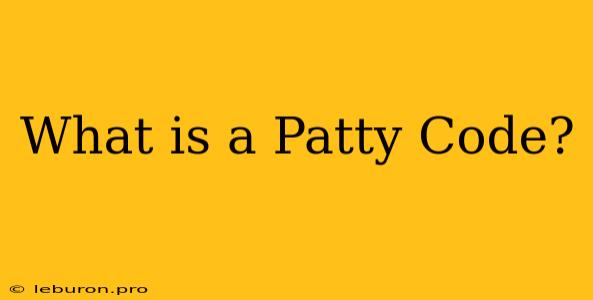The term "Patty Code" might sound like a culinary secret or a secret handshake amongst burger enthusiasts, but it's actually a unique and fascinating concept in the realm of cybersecurity. In essence, a Patty Code is a specific type of code designed to protect sensitive data and systems from unauthorized access. It utilizes a layered approach, much like the ingredients of a juicy hamburger patty, to create a robust security barrier. This code's innovative structure and powerful capabilities have garnered significant attention in the cybersecurity community, sparking interest and raising important questions about its efficacy and potential impact.
Understanding the Layers of a Patty Code
At its core, a Patty Code is a multifaceted approach to cybersecurity, involving a combination of different strategies and technologies. It can be best understood by examining its individual layers, each contributing to the overall security strength:
1. Encryption: The first layer of a Patty Code typically involves encryption, a process of transforming data into an unreadable format, making it incomprehensible to unauthorized individuals. This is similar to scrambling the ingredients of a burger patty, rendering it unrecognizable and inedible to anyone without the "secret recipe." Encryption algorithms, like AES (Advanced Encryption Standard) or RSA, play a crucial role in this layer, ensuring that only authorized individuals with the right decryption key can access the original data.
2. Tokenization: The second layer often involves tokenization, where sensitive data is replaced with unique, random tokens. Imagine this as replacing the actual ingredients of a patty with symbolic representations. These tokens, while appearing similar, hold no intrinsic value or information. Tokenization effectively safeguards the original data by replacing it with a meaningless placeholder, making it challenging for attackers to gain access to the actual sensitive information.
3. Access Control: This layer focuses on limiting access to sensitive data based on user permissions and roles. It's analogous to having multiple security layers around the burger patty, with different levels of access for different individuals. For instance, only authorized personnel might be allowed to access the "secret sauce" or the premium meat, while others may have access only to the basic ingredients. Access control mechanisms, such as role-based access control (RBAC) and multi-factor authentication (MFA), are essential components in ensuring that only authorized individuals can access specific portions of the data.
4. Data Masking: This layer involves hiding or obscuring parts of the data, essentially "masking" specific information within a larger dataset. Consider this as concealing certain ingredients in a burger patty while leaving the overall appearance intact. Data masking techniques like dynamic data masking allow only certain parts of the data to be visible, depending on the user's permissions and the context of access, without compromising the integrity of the entire dataset.
5. Data Monitoring and Anomaly Detection: The final layer emphasizes real-time monitoring and anomaly detection, acting as a watchful eye on the entire system. Think of it as constant surveillance around the burger patty, monitoring any unusual activity or changes. This layer employs tools and technologies to identify and respond to potential threats, such as suspicious access patterns, unusual data usage, or even attempts to tamper with the encryption keys or tokenization mechanisms.
The Importance of a Layered Approach
The Patty Code's success hinges on its layered approach, offering a robust defense against various types of cyberattacks. This layered structure makes it difficult for attackers to compromise the entire system, as they need to bypass multiple security measures to gain access to the sensitive data. Each layer acts as a separate barrier, making it significantly harder for attackers to penetrate and steal data.
Advantages of a Patty Code
Using a Patty Code offers several advantages for organizations seeking to enhance their data security:
- Enhanced Data Protection: The multiple layers of protection significantly reduce the risk of unauthorized access to sensitive data. Each layer acts as a separate barrier, making it more difficult for attackers to penetrate the system and steal information.
- Compliance with Data Privacy Regulations: The Patty Code's ability to effectively protect sensitive data makes it compliant with various data privacy regulations like GDPR (General Data Protection Regulation) and CCPA (California Consumer Privacy Act). These regulations require organizations to implement robust security measures to protect personal data, and the Patty Code provides a comprehensive solution that satisfies these requirements.
- Reduced Risk of Data Breaches: The layered security approach makes it significantly harder for attackers to succeed in data breaches. Even if attackers manage to bypass one layer, they still need to overcome the remaining layers, increasing the complexity of the attack and lowering the chances of success.
- Improved Data Integrity: By effectively securing data, the Patty Code helps ensure data integrity, reducing the risk of manipulation or corruption. This is crucial for organizations that rely on accurate and reliable data for decision-making and other critical operations.
The Future of Patty Codes
The concept of the Patty Code is still evolving, and its future is promising. With the increasing sophistication of cyberattacks, organizations need to implement more robust and sophisticated security solutions. The Patty Code's layered approach and its flexibility to adapt to evolving threats make it a potential game-changer in the field of cybersecurity.
Conclusion:
A Patty Code, with its multiple layers of protection, offers a powerful and comprehensive approach to securing sensitive data. Its layered approach, combined with its ability to adapt to evolving threats, makes it a vital tool for organizations seeking to enhance their cybersecurity posture and protect their most valuable assets. While the concept is still evolving, the Patty Code's potential impact on the cybersecurity landscape is undeniable, promising a future where data is better protected and the risk of cyberattacks is significantly reduced.
